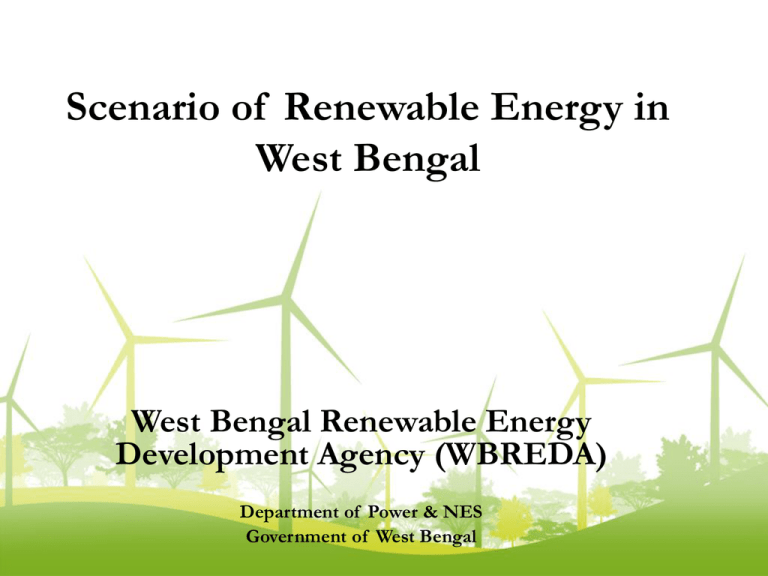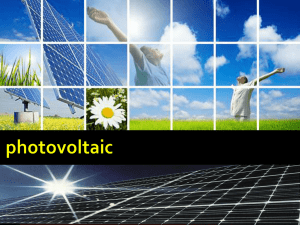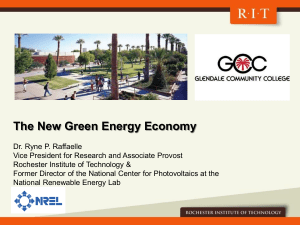West Bengal Renewable Energy Development Agency
advertisement

Scenario of Renewable Energy in West Bengal West Bengal Renewable Energy Development Agency (WBREDA) Department of Power & NES Government of West Bengal Indian Renewable Energy Scenario The energy scenario in India is a complex mix of a variety of energy sources including traditional fuels (also called non-commercial fuels) such as firewood, agricultural wastes and animal wastes have played a significant role, particularly in rural areas. Critical analysis of Indian energy scenario suggests that India would continue to be a net importer of energy for a long time which is a threat to its energy security. • India may have to import about 85% of its oil, 70% of its coal and 60% of its gas requirements in 2031. Even then Power generating capacity may reach only 795,000 MW indicating continuing shortages for decades to come. (study done for the Office of the Principal Scientific Adviser to the Prime Minister and TERI ) India faces on an average 17% power shortage during the peak hours (morning and evening peak) and almost 40% of our population is deprived of electricity till date. Each unit of coal generated electricity generation means emission of average 830 grams of carbon dioxide to the atmosphere. 2 Indian Renewable Energy Scenario ….(contd.) If India has to maintain the present projections of GDP growth the following will be needed: ⁻ Increase in Coal supply from 500 million tones in 2006-07 to over 2,500 million tonnes in 2031-32 ⁻ Six-fold increase in Power generating capacity from about 150,000 MW to 900,000 MW in 2032. This will enhance GHG (Green House Gases) emission level by manifold. Therefore, energy efficiency and application of renewable energy in domestic, commercial & industrial sectors is imperative for India to meet the goals of economic development as well as achieve the target towards emission reduction. To achieve energy security, Government of India has initiated number of programmes targeting energy conservation, improving energy use efficiency and promoting optimal energy mix. 3 The long term potential of various renewable energy sources in the country and status of utilization (as on 31.12.2010) are as follows : Energy Source Potential (MW) Cum. Achievement (MW) Biomass 16880 997 Bagasse cogen 5000 1562 Wind power 45000 13065 Small Hydro 15000 2939 Urban & Industrial Wastes 2700 72 Solar power 900,000 @ 1% land use 17 (Source: MNRE website) 4 The West Bengal State Electricity Regulatory Commission (WBSERC) has declared the Renewable Purchase Obligation (RPO) for all distribution utilities of West Bengal; as below: Year Licensees WBSEDCL % CESC Ltd % DPL % DPSC Ltd % DVC % 2010-11 2 2 2 2 2 2011-12 3 3 3 3 3 2012-13 4 4 4 4 4 5 Potential of Renewable Power in the state of West Bengal 1. Wind Power Potential 2. Biomass Potential 3. Small Hydro drop) 4. Solar PV (assuming 1% of the state) 5. Solar Roof Top 6. Solar Thermal equivalent) 7. Waste to Energy 6 - 450 MW 350 MW 300 MW(including canal - 16000 MW 300 MW 400 MW (Electricity - 150 MW Total: 17,900 MW 7 West Bengal Scenario WBREDA is working with Renewable Energy & energy Efficiency in the state of West Bengal. The main objectives of such works are:To provide electricity in un-electrified areas Chopping the peak demand of electricity from conventional sources To mitigate climate change problems To ensure energy security of the country 8 Works of WBREDA Solar Photovoltaic Programmes:- [Here electricity is produced from Sun Light]: Solar Lantern, Home Lighting System, Street Lighting System, Solar Inverter, Solar Power Plant, Solar Generator, Remote Village Electrification, Solar Powered Signboard, Solar Powered Mobile Tower, Solar Pump, Solar PV Electrification at School, College, Institutions. Solar Thermal Programme:- [Here heat energy of the sun is utilised]: Solar Water Heating Systems for domestic premises, institution & commercial establishments. Solar Cooker for individual, community and commercial use; Solar Drier, Solar Air-conditioning System. Wind Energy Programme:- [Electricity generation from wind]: Wind Electric Generator, Aero generator, Wind-Diesel Hybrid, Wind-Biomass Hybrid Projects Bio Energy:- Biogas plant for domestic & community use. Biogas for electricity. Biomass grassfire for electrifity and thermal applications at Rice Mill, Bakery, Tea Factory, Processing Plants. etc. Almost 2 lacs of family size biogas plants have been installed so far in West Bengal. Battery operated vehicle:- Battery operated Two Wheeler, Three Wheeler, Four Wheelers are being promoted by WBREDA. So far, more than 10 thousands battery operated two wheelers have been sold in West Bengal. 9 Works of WBREDA Remote Village Electrification (RVE) :- Providing electricity at remote & isolated locations through solar photovoltaic Systems. More than 100 such villages have been electrified so far. Rabirashmi Abasan:-: The first Solar Housing complexmin the country at New Town, Kolkata. Small Hydro project:- Small Hydro Projects for rural electrification, institutional electrification, supply of electricity to the grid etc. Tidal Power:- A scheme for production of electricity from the tides is being conceived at Durgadowani, Gosaba. Energy from Municipal Solid Waste:- Some technology demonstration projects at Howrah Municipal Corporation, Baruipur Municipality, South Dum Dum Municipality, English Bazar Municipality have been initiated. Geothermal Energy:- Investigation is being taken up. Information & Public Awareness:- Different programmes for creating large scale public awareness among the people: Participation in Fairs & Exhibitions, Display Boards, Demonstration Programmes, Publications, Aditya Solar Shop (Alipore, Durgapur, Siliguri), Renewable Energy Clubs etc. Capacity Building:- Training programmes at technician level, engineers level etc. for capacity building. WBREDA provides support for research works in Renewable Energy & climate change. 10 Energy Efficiency Programme:- Through different measures (procurement of energy efficient appliances and use of appliances in efficient manner); conservation of lectricity can be done and this saved electricity can be supplied to unelectrified areas. WBREDA works for Energy efficiency by large scale public awareness through publication, exhibition, display, demonstration, training programmes etc. Available Renewable Energy technologies/products and Subsidy Schemes from WBREDA Name of the System Solar PV Lantern System description 10 Wp module, 7 AH battery, 7 W C.F. Lamp, Working hours 5 hrs. Tentative Cost Per System Tentative Subsidy Per System 2,174/- 500/- Home Lighting System Module, battery, charge controller unit, C. F. Lamp @ 270/- per Wp 30% of the system cost Solar PV Street Lighting System Module, battery, charge controller unit, C. F. Lamp, Pole Rs. 271/- per Wp. 30% of system cost Solar PV Power Plant Module, battery, charge controller unit, C. F. Lamp, Fan, TV, Computer etc. @ 270/- per Wp 30% of system cost for non profitable agency & 23% for profitable agency Solar Cooker: family type This type of Cooker can cook meal for 6 to 10 persons at a time. All type of cooking (boil, fry etc.) can be done within 30 to 45 minutes Rs. 5000/- Rs. 500/- 11 Solar Water Heating System Different size of Rs. 23310/- for a systems are available 100 LPD system in the market, (ETC) starting 100 liter per day (LPD) Battery driven E-Bike Low and High speed two wheeler, 7 setter three wheelers are available in the market Rs. 5000/- for a 100 LPD system (ETC) This is a pollution free vehicle and Govt. is providing different type of Incentives for its promotion. Bio-gas Plant 1 cu.mtr. plant Rs. 10000/- to Rs. 12000/- Rs. 4000/- Bio-gas Plant 2 cu.mtr. plant Rs. 200000/- to Rs. 24000/- for areas in Darjeeling and Sundarbans. Rs. 10000/- for areas in Darjeeling and Sundarbans & Rs.16,000/- to 20,000/- for areas other than Darjeeling and Sundarbans Rs. 8000/- for areas other than Darjeeling and Sundarbans 12 The cost & subsidy varies time to time.For up to date information websites of WBREDA (www.wbreda.org) & of MNRE(www.mnre.gov.in) may be consulted. Solar Energy Solar radiation is abundantly available in West Bengal. The best solar insolation is available at western part of state (Bankura, Purulia & West Medinipur Districts). For the balance portion of the state, 320 sunny days in a year is available. WBREDA activities regarding solar energy is given below: Sl. No. 1. Type of project Grid connected Solar PV Project Remarks Only one such project has been installed so far in West Bengal, capacity- 1MW at Jamuria near Asansol 2. Do One project has been installed at a school near Tollygunj, Kolkata, where from excess power is being pushed to the CESC grid. Similar some other projects are in the pipeline. 3. Off grid power plant 13 nos. of Solar PV Power Plants have been installed so far since February, 1996 with aggregated capacity of 624 KWp. These plants are providing electricity to the local people through local mini grid. 4. Solar PV Home Lighting System Nearly 2 lacs of such systems have been installed so far across the state. These type of systems have module (18Wp, 37 Wp, 50 Wp, 74 Wp, 100 Wp), battery with matching capacity, cables and switches, matching load (light, fan, TV, Music System etc.) 13 5. Solar PV Lantern It is being used both at electrified (as single source of light) and un electrified (as emergency charger) areas. 6. Solar PV Pump Some technology demonstration projects have been completed so far for irrigation and drinking water purposes. 7. Solar PV Street Lighting System Nearly 10 thousands of such systems have been installed so far across the state. These type of systems have module (74 Wp, 100 Wp), battery with matching capacity, cables and control systems matching load (11/ 18W CF Lamp). 8. Solar PV Power Plant More than 100 institutions which includes schools, students hostels, hospitals, health centers, offices etc. have been given electricity through Solar PV Power Plants. (capacity in the range of 1KWp to 100 KWp). 14 Wind Energy: • India ranks fourth in terms of wind energy in the world and at present, it harnessed only onefourth of the potential which amounts to around 10,000 MW • India has a total wind power potential of 45,000 MW and vast on-shore and off-shore wind potential still remains to be tapped. • The state of West Bengal arguably has a wind power potential of 450 MW without considering off-shore potential but some of it may not be realizable due to various barriers like land issue and non-availability of grid in some parts of Sundarbans. • At present the state is generating only 1 MU of wind power annually. The installed capacity of wind power plant in West Bengal is 2.5 MW. • The rage wind speed in the state is very low and as such, not many investors are interested in this sector. • However with appropriate policies and incentives under the State Climate Action Plan the state can achieve at best 460 MW wind power by the year 2030 (including off-shore generation), out of which 150 MW may become operational by the year 2020-21. 15 Biomass India has a high potential of Biomass (any material derived from growing organism) both in form of agricultural waste and forest waste. Estimated Biomass power potential of India is 25,000 MW. Electricity can be produced from Biomass through two routes: ⁻ ⁻ Biomass Combustion. Biomass Gasification. The State of West Bengal has a total potential to generate around 350 MW electricity from Biomass without considering Energy plantation programme which is also a carbon neutral programme. Presently the state has an installed capacity of 80 MW in this sector and shortly this will touch 100 MW. The average PLF of such plant is high in the range of 70 – 75%. 16 Government Policies and Incentives The National Solar Mission is one of the most important policies that seeks to create policy conditions necessary to promote the diffusion of solar energy use all over the country. The following are some of the fiscal and policy incentives available now for production and use of solar energy systems: • • • • • • 17 100% foreign direct investment allowed in manufacturing and power projects. Zero customs and excise duties on wafers, solar cells, modules and some raw materials. 5% customs and excise duty on other raw materials and components. Tax holiday for manufacturing units in backward and specified areas, and for power projects. 80% depreciation in the first year for capital investments on solar projects. Support for R&D and technology validation projects. Proposed Climate Action Plan of the State: Generation need for emission reduction: Solar Power is the main renewable energy source of the state and without considering Solar Energy the total potential of the state is only 1250 MW. In order to reduce power sector emission by about 20% the state needs to produce 2,000 MW of renewable power by the year 2020-21 . Share of Solar in this will be 1600 MW To reduce the same by 30% it needs to produce 3,000 MW of renewable power by the year 2030-31 out of which 2400 MW needs to be from solar energy. Alternatively, the state can buy a portion of renewable power from other states to reduce its emission intensity. Projection and plans for generation: As per plans and projections under the State Climate Action Plan the state of West Bengal may be able to generate 250 MW of Solar power till 2015 and 750 MW till 2020. During next decade the state of West Bengal may plan for 1500 MW of Solar power installation. The State will generate additional 100 MW power from Solar Roof Top by the year 2020 and 300 MW from Solar Roof Top by the year 2030-31. The grid parity of Solar power is expected to come only in the year 2015. As such, till such time Solar Power Plant will run on subsidy. The Solar Water Heating programme will also play a significant role in reducing demand. 18 Table below shows the Installation programmes of RE technologies in the state upto 2020-21 and 2030-31. Sl.No. Source: 2020-21 2030-31 1. Wind Farm and other Small Wind system. 150 MW 250 MW 2. Biomass 150 MW 200 MW 3. Small Hydro 200 MW 100 MW 4. Waste to Energy 50 MW 100 MW 5. Roof Top Solar PV 100 MW 200 MW 6. Solar Farm 1000 MW 1500 MW 7. Solar Water Heating system 150 MW (Electrical equivalent) 250 MW (Electrical equivalent) 8. Other Solar Energy programme like Solar Street lights, Replacement of Bill Board, Community lights, etc. and Off grid system. 200 MW 400 MW 2000 MW 3000 MW Total:- 19 Infrastructure Requirement: The following infrastructure has to be created in the state for achieving the target. a) Wind:• 1 MW of wind power plant needs 12 acres of land. • It would be necessary to identify 2500 acres of Land (Non-agricultural) in those areas for setting up of the wind farms. Side by side the power evacuation network shall also be required to be created. • The state of West Bengal has wind power potential in: South 24 Parganas (Fraserganj, Sagar, Part of Kakdwip). Purba Midnapur (Dadanpatrabar, Coastal areas of Kanthi and Contai Sub-Division). b) Solar : 1 MW Solar power plant needs 4 acres of land (in case of crystalline silicon) and 8 acres of land (in case of thin film Solar cells). It is presumed that the efficiency of Solar cells shall be almost double by the year 2030-31 from the present level. The state will need 6,000 acres of land (non-agricultural) by the year 2020-21 for Solar farm projects and additional 6,000 acres of land by the year 2030-31. The state has good Solar Radiation in Purulia & Bankura and it is expected most of Solar power plants will be set up in these two districts. 20 Additionally the Western part of Burdwan and Birbhum districts also have encouraging potential for solar power. Infrastructure Requirement …….(contd.) c) Biomass and Small Hydro:- • These type of projects may not be so significant like Solar and Wind project. However, in case of small hydel project some forests and forest lands will be involved. The total land area required to achieve 5000 MW of Renewable Power shall be 17,100 acre which is 0.03% of the total land area of the state. It is necessary to earmark the 17,000 acres of land for development of Solar Farm and Wind Farm in the state of West Bengal. The table below gives a picture of land requirement for setting up of various types of renewable energy power projects in the state. Land requirement has been calculated based on the target as stipulated earlier:- Type of Power Plant Requirement of Land 2020-21 2030-31 * Wind Power 2500 Acres 1800 Acres * Biomass 350 Acres 450 Acres * Small Hydro Not significant. However, Forest land will be involved. Not significant. However, Forest land will be involved. * Solar Power 6000 Acres 6000 Acres 8850 Acres 21 8250 Acres Total THANK YOU 22








